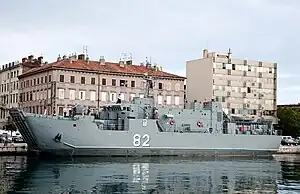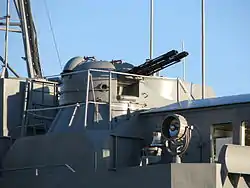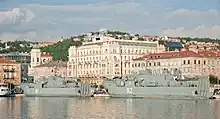 Krka (DBM-82) photographed in Rijeka on 17 September 2009 during the Croatian Navy day. | |
| Class overview | |
|---|---|
| Builders | Brodogradilište specijalnih objekata (BSO), Split |
| Built | 1980s–1994 |
| Completed | 3 |
| Active | 2 |
| General characteristics | |
| Length | 49.69 m (163 ft 0 in) |
| Beam | 10.2 m (33 ft 6 in) |
| Draft | 2.6 m (8 ft 6 in) |
| Propulsion |
|
| Speed | Maximum: 12.5 knots (23.2 km/h; 14.4 mph) |
| Range | 1,200–1,400 nmi (2,200–2,600 km; 1,400–1,600 mi) at 12 knots (22 km/h; 14 mph) |
| Endurance | 12 days |
| Complement | 32 |
| Armament |
|
The Silba class (sometimes the Cetina class) is a class of three landing ships, also used as minelayers, built for the Yugoslav (JRM) and Croatian Navy (HRM) during the 1980s and 1990s. The ships were built at the Brodogradilište specijalnih objekata shipyard in Split with slight differences in armament configuration between the last two ships. By the time the Croatian War of Independence started, one ship was in service with the JRM while another was being completed.
The one in JRM service was relocated to Montenegro where it would be commissioned with the Navy of the new FR Yugoslavia. The second ship that was captured unfinished was completed by Croatian forces and entered service with the HRM, followed by a third that was laid down by Croatia in 1993. The two ships commissioned with the HRM remain in active service, providing assistance to civilian institutions aside from their regular military tasks. The first ship in the class is currently decommissioned and in reserve in the Bay of Kotor, Montenegro.
Development and building
The Silba class was developed by the Brodarski institut (BI) from Zagreb as a replacement for a large number of aging barge-like landing craft based on German World War II designs (Marinefährprahm and Siebel).[1] All three ships were completed at the Brodogradilište specijalnih objekata (BSO) in Split, Croatia. The first one, Krk (DBM-241), was commissioned with the JRM sometime between 1986 and 1990.[2][3] The keel for the second ship that was to be named Rab (DBM-242) was laid down in 1990.[2][4] As the Croatian War of Independence started, unfinished Rab was captured by Croatian forces. It was completed and launched as Cetina (DBM-81) on 18 July 1992. A third and final ship was launched on 17 September 1994 as Krka (DBM-82).[4]
Description
These ferry-like ships feature a roll-on/roll-off design with two loading ramps located on the bow and the stern.[5] Measuring 49.69 m (163 ft 0 in) in length, they have a 10.2 m (33 ft 6 in) beam with a 2.6 m (8 ft 6 in) draft. Propulsion consists of two 1,140 kW (1,530 hp) Burmeister & Wain Alpha Diesel 10V 23L VO engines mounted on two shafts, enabling them a maximum speed of 12.5 knots (23.2 km/h; 14.4 mph) and a cruising speed of 12 knots (22 km/h; 14 mph). Traveling at their cruise speed they have a range of 1,200–1,400 nautical miles (2,200–2,600 km; 1,400–1,600 mi) with a 12-day endurance. The ships are manned by a crew of 32.[6]
The armament configuration differs between the first two ships and the last one; DBM-241 and DBM-81 are armed with two AK-230 CIWS mounted on the sides, a single quadruple 20 mm (0.79 in) M-75 gun on the stern and a single quadruple MTU-4 9K32M Strela-2M (SA-7b "Grail") anti-aircraft missile launcher. The interior, which features two mine rails, can be used to carry up to 152 different naval mines, six medium tanks or 300 troops with equipment, a total cargo capacity of 460 t (450 long tons). DBM-82 was completed with a different gun armament; in place of the AK-230, DBM-82 has two 20 mm M-71 guns on the sides and a single Bofors D70 40 mm (1.6 in) gun on the bow. The ship was also completed as an auxiliary water carrier with a capacity of around 230 t (230 long tons) of fresh water.[7][5] The number of mines that DBM-82 can carry is a maximum of 114.[4]
Ships
| Name | Pennant number[8][4] | Namesake | Builder[3] | Laid down[4] | Launched[4] | Commissioned[4] | Fate |
|---|---|---|---|---|---|---|---|
| Krk | DBM-241 | Krk | Brodogradilište specijalnih objekata, Split, Croatia |
— |
— |
— |
decommissioned; In Montenegro |
| Cetina (Rab) |
DBM-81 (DBM-242) |
Cetina (Rab) |
1990 | 18 July 1992 | 19 February 1993 | In service with the Croatian Navy[4] | |
| Krka | DBM-82 | Krka | 19 February 1993 | 17 September 1994 | 9 March 1995 | In service with the Croatian Navy[4] |
Service history

At the start of the Croatian War of Independence DBM-241 was relocated to Montenegro where it later entered service with the SR Yugoslav Navy. DBM-242, now redesignated as DBM-81 was launched as Cetina and entered service with the Croatian Navy 19 February 1992 with Ivo Raffanelli in command. For the remainder of the war, Cetina was engaged in transporting troops and equipment along the coast, including supply runs for Croatian forces during Operation Maslenica in 1993. The same year the ship participated in testing of the new MNS-M90 naval mine. DBM-82, the third and final ship of the class, was commissioned with the Croatian Navy on 9 March 1995 with Jerko Bošnjak in command.[4]
According to publications and news reports, DBM-241 was reported operational as late as 2005.[9][10] An article published in October 2012 reported that the Egyptian Navy bought DBM-241 a year earlier. Although the advance was paid, the official handover of the ship has not happened by the time the article was published.[8] As of March 2014, the official website of the Armed Forces of Montenegro does not list DBM-241 among its fleet:[11] the ship is currently in reserve in the Bay of Kotor, opposite Đenovići. The two Silba-class vessels in Croatian hands continue to see service the Navy Flotilla performing traditional naval tasks as well as support missions for civilian institutions such water supply and transporting firefighters.[7][12]

In July 2006 Krka was damaged during an overhaul at the Šibenik Shipyard. While being lowered to the sea, the winch of the syncrolift pulled out of the concrete causing the ship to fall down, creating a hole in the hull and sinking the stern. Early reports of significant damage proved to be false and the ship was repaired soon after. Out of ten crew members that were on board at the time, only one sustained minor injuries.[13][14]
In 2015, Krka and Cetina were tasked with transporting Croatian Army vehicles and personnel to Spain for the NATO "Trident Juncture" exercise. The ships departed the Lora Naval Base on 11 October 2015, loaded with four Patria AMVs, two trucks, one motor vehicle and 14 soldiers scheduled to take part in the exercise.[15] On 13 October they arrived in Catania where they rendezvoused with Andrija Mohorovičić deployed in support of Operation Triton. The two ships made another stop at Cagliari before continuing to Spain, arriving in Sagunto on 18 October after spending seven days at sea.[16] The ships returned to the Lora Naval Base on 13 November, concluding their month long deployment during which they traversed a total of 2,700 nautical miles (5,000 kilometres; 3,100 miles).[17]
See also
Notes
- ↑ Gardiner 1995, p. 646.
- 1 2 Wertheim 2007, p. 147.
- 1 2 Review of delivered vessels since 1980.
- 1 2 3 4 5 6 7 8 9 10 Flotila HRM.
- 1 2 Saunders 2004, p. 164.
- ↑ Brodovi flote HRM u vježbi "Phiblex".
- 1 2 Čizmić & 8 August 2007.
- 1 2 Luković & 16 October 2012.
- ↑ Kalajdžić & 16 April 2004.
- ↑ Saunders 2004, p. 653.
- ↑ Naoružanje i oprema Mornarice.
- ↑ Puljizević & May 2011.
- ↑ Jutarnji list & 4 July 2006.
- ↑ Grubač & 12 July 2006.
- ↑ Valentić Mikšik & 22 October 2015.
- ↑ Knežević & 18 October 2015.
- ↑ Povratak brodova HRM-a s NATO vježbe u Španjolskoj & 13 November 2015.
References
Books
- Gardiner, Robert (1995). Conway's All the World's Fighting Ships 1947–1995. Naval Institute Press. ISBN 978-0-85177-605-7.
- Saunders, Stephen (2004). Jane's Fighting Ships 2004–2005. Jane's Information Group Limited. ISBN 0-7106-2623-1. OL 7790644M.
- Wertheim, Eric (2007). The Naval Institute Guide to Combat Fleets of the World, 15th Edition: Their Ships, Aircraft And Systems. Naval Institute Press. ISBN 978-1-59114-955-2.
News reports
- Čizmić, Martina (8 August 2007). "Na Kornatima uginulo gotovo 1500 ovaca" [1500 sheep die on Kornati]. Nacional. Retrieved 12 March 2014.
- Grubač, Jordanka (12 July 2006). "Veća šteta na dizalici nego na brodu" [Damage to the crane more extensive than to the ship]. Slobodna Dalmacija. Retrieved 27 March 2014.
- "Havarija na desantnom minopolagaču Krka" [Breakdown on the landing ship-minelayer Krka]. Jutarnji list. 4 July 2006. Retrieved 27 March 2014.
- Kalajdžić, Ahmet (16 April 2004). "Kafići u utrobi ruzinave flote" [Caffés in the belly of a rusty fleet]. Slobodna Dalmacija. Retrieved 10 March 2014.
- Luković, Siniša (16 October 2012). "Ministarstvo prodaje Cofisu radionicu za torpeda" [The Ministry of Defense to sell the torpedo shop to Cofis]. Vijesti. Retrieved 12 March 2014.
- Puljizević, Lada (May 2011). "OSRH spreman za PP sezonu" [OSRH ready for the PP season]. Hrvatski vojnik. Retrieved 12 March 2014.
- Valentić Mikšik, Ivana (22 October 2015). "Pripadnici OSRH ispraćeni na vježbu Trident Juncture 15". Hrvatski vojnik. Retrieved 3 June 2016.
- Knežević, Lidija (18 October 2015). ""Krka" i "Cetina" doplovile u Španjolsku". Obrana i sigurnost. Retrieved 4 June 2016.
- "Povratak brodova HRM-a s NATO vježbe u Španjolskoj". Ministry of Defence. 13 November 2015. Retrieved 4 June 2016.
Other sources
- "Brodovi flote HRM u vježbi "Phiblex"" [Ships of the HRM fleet in the "Phiblex" exercise]. Hrvatski vojnik. October 2000. Archived from the original on 8 February 2010. Retrieved 16 February 2014.
- "Flotila HRM" [HRM Flotilla]. Armed Forces of the Republic of Croatia. Retrieved 12 March 2014.
- "Naoružanje i oprema Mornarice" [Armament and equipment of the Navy]. Armed Forces of Montenegro. Archived from the original on 23 February 2014. Retrieved 12 March 2014.
- "Review of delivered vessels since 1980" (PDF). Brodogradilište specijalnih objekata. Archived from the original (PDF) on 13 March 2014. Retrieved 13 March 2014.